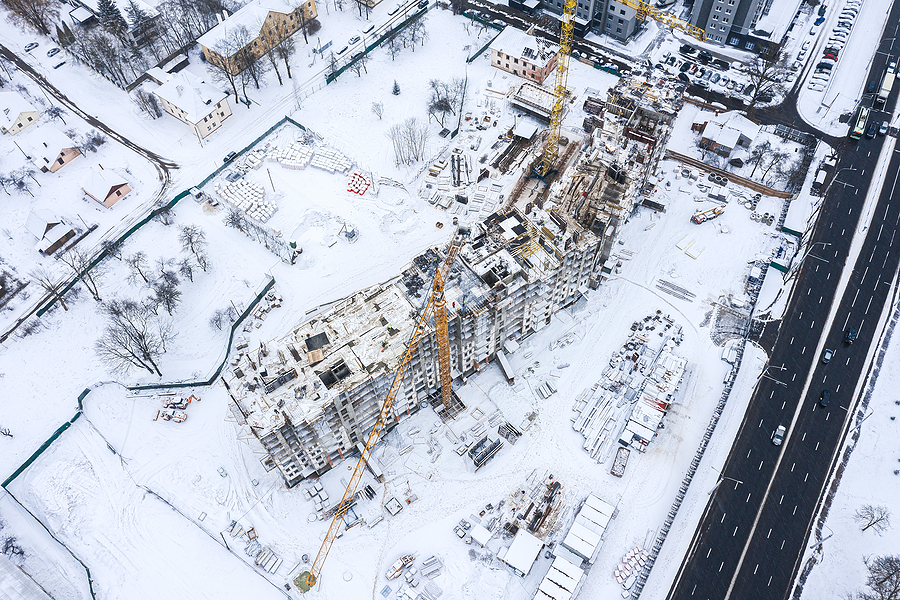Winter in the northern states can be brutal. Michigan, Wisconsin, Montana, and North Dakota get very cold — and very wet. Yet construction continues in all types of weather. That’s why preparedness is crucial when temperatures plummet and the elements have a field day.
Here are four smart ways to keep your crew safe this winter.
Skip the slip
Comedians have used pratfalls since time immemorial. But there’s nothing funny about slip and fall accidents, which resulted in almost 25,000 injuries in the construction industry in 2016, according to the National Safety Council. Construction workers are at seven times the risk of fatal falls from heights, compared with other industries.
The National Institute for Occupational Safety and Health (NIOSH) and National Occupational Research Agenda (NORA) – Construction Sector recommend the following winter awareness safety tips:
- Plan ahead. Anticipate potential fall hazards, then select appropriate fall protection for the job, such as personal fall arrest systems.
- Train your team. While everyone in construction probably knows how to use a ladder, revisiting such basics may be just the brush-up they need to stay safe on job sites this winter.
- Monitor weather forecasts. Knowing there’s a storm on the way can prevent unnecessary hazards. Beyond salting walkways and work areas, you can use this time for an indoor job.
Know your snow
Snow is beautiful if you’re going skiing. When it needs to be shoveled, not so much. In fact, snow shoveling, done incorrectly, can be dangerous. According to one 17-year study, there were an estimated 11,500 snow shovel-related injuries and medical emergencies treated annually in U.S. emergency rooms.
Before any member of your crew attempts to remove snow, be sure everyone is familiar with the following snow shoveling tips:
- Warm up your muscles as you would for any physical workout.
- Dress in layers, covering the face and neck to avoid directly inhaling frigid air.
- Stay hydrated with water and juice, not coffee or tea, which promote dehydration.
- Pace yourself. Take frequent rest, stretch, and hydrate breaks.
- Lift properly. Wet snow can weigh 15-20 pounds. Aim to push rather than lift it. If you do need to lift, squat and lift with your legs, rather than bending at the waist.
Winterize work vehicles
Did you know over 70 percent of U.S. roads are located in snowy regions? According to the U.S. Department of Transportation, nearly a fourth of weather-related crashes happen on snowy, slushy, or icy roads, killing 1,300 people and injuring more than 116,800.
Educate your team about how to drive and operate machinery in hazardous winter weather. Vehicles should be inspected daily to ensure they’re in good condition. While construction workers don’t need to become mechanics, OSHA recommends all employees be trained to inspect the following systems for safety in winter driving:
- Brakes and brake fluid level
- Cooling system and mixture
- Electrical system: battery, alternator belt, and all electrical connections
- Engine
- Exhaust system: no leaks, clamps and hangers snug
- Tires: proper tread depth and tire inflation
- Oil: at proper level
- Visibility systems: all exterior lights, defrosters (windshield and rear window), and wipers in good condition
Dress the part
People in office jobs are advised to “dress for success” — but when it comes to winter construction, a more accurate recommendation might be “dress to excess.” This means proper PPE, including:
- Waterproof safety boots with non-slip soles. Choose safety boots without steel tips — metal is a frostbite magnet. Instead, double up on socks.
- Layered, loose fitting clothing. OSHA recommends three layers: an inner wool layer to wick away moisture, a polypropylene middle layer for insulation, and a waterproof jacket, ideally with a removable inner lining.
- Hard hats with liners. Although the belief that we lose most of our body heat through our head has been debunked, extreme cold still places great stress on the body. If your core temperature drops below 95º, you risk hypothermia and even frostbite.
- Gloves, a necessity for construction work, are also essential cold weather protection. Remind your team to keep their gloves on when climbing ladders, scaffolding, or other equipment, because touching cold metal bare-handed can cause immediate frostbite.
- Goggles, safety glasses, facemasks. In the COVID era, facemasks are a given. For the construction site, treat goggles and safety glasses with anti-fog spray to maintain clear vision.
Ready to learn more about how to keep your crew safe this winter? Contact Trimedia’s health and safety experts today.
Our services include:
- Safety plan development
- Employee health and safety training
- Safety oversight
- And more

